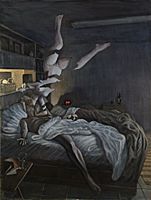
The Phantom, 2004, oil on canvas,
48 x 36 inches |
I
was a little worried about the premise of this show, idea to
image, because for me it usually works the other way around--image
to idea. I'm continually ambushed by images that do not come
with explanatory notes attached. I usually begin to interpret
an image right away--it's human nature to try to figure things
out--but it has sometimes been years after the completion of
a painting that I finally get the idea. There are times
when I have an idea first and try to generate an image from it,
but that usually doesn't work for me.
However, it's impossible
to completely separate these two terms, idea and image. I'm using
them in the modern sense of image as something seen and idea
as something thought. But idea comes from the Greek verb idein,
to see. And even now we all know that a light bulb over the head
represents an idea. We say, "I see!" when we understand
something. So this whole image-idea dichotomy may be largely
semantic. Especially since the "images" that I say
I'm ambushed by are sometimes imaginary, appearing in my head
while listening to music or reading. Are those images or ideas?
Ordinarily, though, the images that capture me are things seen
at moments when I am not looking for something to paint. It's
usually some quite ordinary arrangement of objects or people,
something seen while driving, or even, most recently, the cluttered
desk right under my nose! Since there's nothing rare and exotic
about a roll of toilet paper in the bathroom or a box on the
kitchen counter, and since I've seen these things countless times
already without being inspired by them--it must be the subject,
I, and not the objects that have changed! Maybe I'm not quite
the same person I was the last time I looked at them. Maybe art
is the attempt, however futile, to snatch these rare bits of
oneself out of the rush of time. Previously I was familiar with
the image but not conscious of it. Is it in that moment of the
ambush that an image becomes an idea?
These moments are fleeting and unstable for me. If I don't do
a sketch immediately, it's gone. There has to be something tangible
to pin it down. So is the image capturing me or am I capturing
it? Maybe both. In his book, Stealing the Mona Lisa, Darien
Leader considers two statements: "An image is a human-capturing
device," and "A human being is an image-capturing device."
He debates which statement is correct, but to me they are two
sides of the same coin. In art as in love, we want to capture
that which captured us. But just as the one we fall in love with
is never whom we think, so the work of art is never that image
that first grabbed us. Instead we create something quite different.
The work of art is that passionate failure to capture a momentary
image. It's literally an attempt to stop time. So the goal is
always an illusive phantom, obscured by flights of birds, vanished
into the sea. The art object is the never the attainment of the
goal but a substitute for it, a mute witness to the struggle.
You should have realized by now that I haven't told you anything
about the paintings in this show. I've avoided the issue because
I think it's better for artists to keep their mouths shut about
their own stuff, mainly because we don't know any more about
it than you do. If we mouth off about what we do know, or think
we know, it can mess up whatever personal associations to the
work you might have discovered on your own. If the creative process
is mostly unconscious--image first, idea later--why shouldn't
it be the same with you, the viewer? It's always you, not the
artist, who are the final authority on the work.
Warren Criswell
|